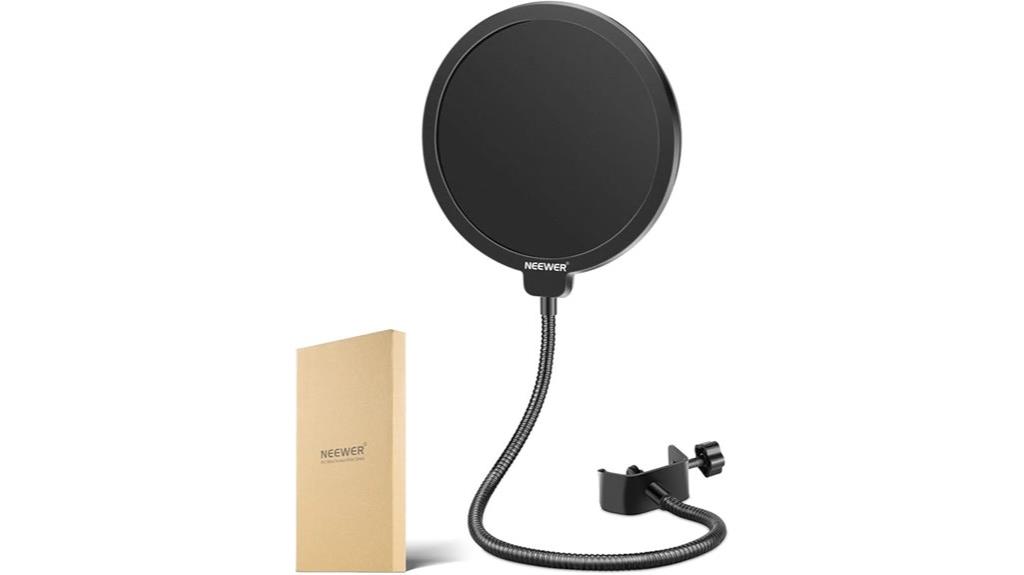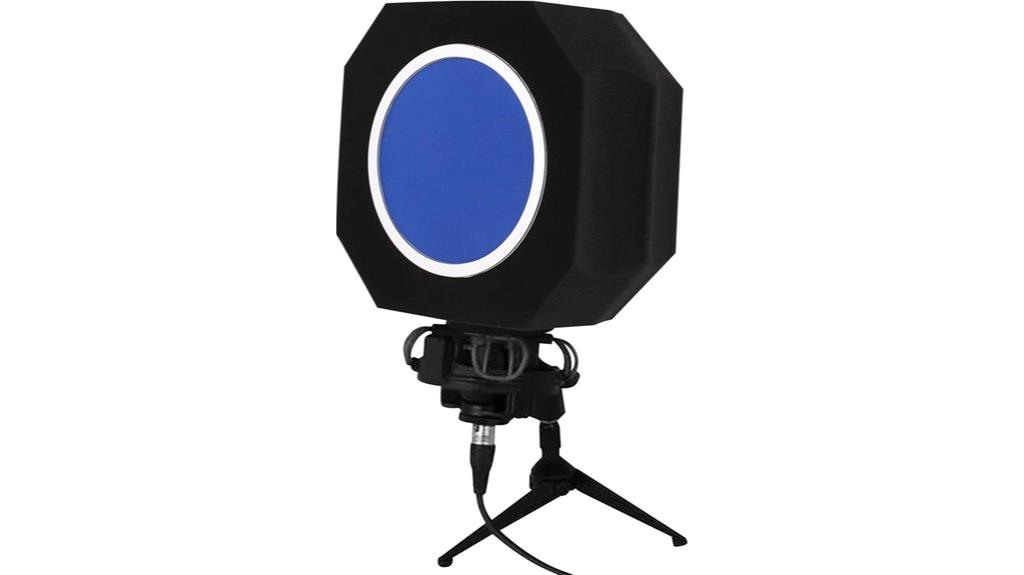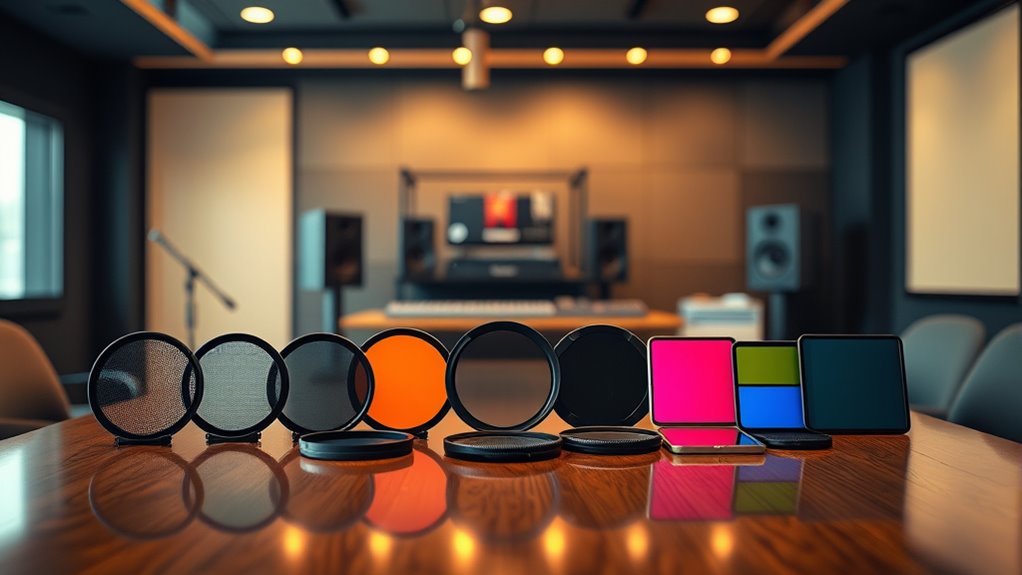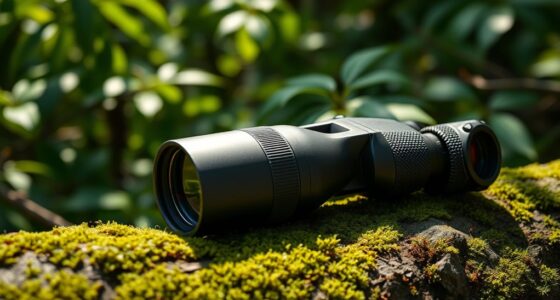If you’re looking to enhance your sound quality in 2025, I’ve found some of the best pop filters available. Options like the Aokeo Professional Pop Filter and the Neewer Shield are great for reducing plosive sounds. The Warm Audio Metal Pop Filter stands out for its durability and clarity. Each filter has its unique features and benefits, ensuring you’ll find one that fits your needs. Stick around to explore the top choices in detail!
Key Takeaways
- Consider pop filters with dual-layer or three-layer designs for effective plosive sound reduction and improved audio clarity in recordings.
- Look for adjustable goosenecks and sturdy clamps to ensure secure positioning and compatibility with various microphone types.
- Lightweight and portable models facilitate easy transport and quick setup in different recording environments, enhancing usability.
- High customer ratings indicate the effectiveness of popular models, highlighting their contribution to achieving professional-sounding recordings.
- Evaluate performance characteristics, such as noise reduction efficiency and material choice, to find the best pop filter for your specific needs.
Aokeo Professional Microphone Pop Filter Mask Shield

If you’re a content creator, such as a podcaster or streamer, the Aokeo Professional Microphone Pop Filter Mask Shield is a fantastic choice for enhancing your sound quality. It’s designed for microphones like the Blue Yeti and features a double-layered wind pop screen that effectively blocks air blasts. I love how the adjustable clamp secures it firmly without slipping. The flexible gooseneck makes it easy to find the perfect angle. With an average rating of 4.5 stars, this filter reduces unwanted hissing and plosives, making my recordings sound more professional. It’s a cost-effective solution I highly recommend!
Best For: Content creators, including podcasters and streamers, looking to enhance their audio quality with a reliable pop filter.
Pros:
- Effectively reduces plosive sounds and hissing for clearer vocal recordings.
- Adjustable clamp and flexible gooseneck allow for easy positioning and stability.
- Affordable price point for the quality it delivers, making it accessible for various users.
Cons:
- Some users report minor issues with the gooseneck adjustment not holding in place securely.
- May not fit all microphone types perfectly, depending on size and design.
- The double-layered design could be bulkier for some setups compared to simpler models.
Aokeo Upgraded Pop Filter for Microphone

The Aokeo Upgraded Pop Filter for Microphone is an excellent choice for anyone looking to enhance their recording quality, especially those using popular models like the AT2020 or AT2035. Its three-layer design effectively reduces plosives and unwanted noise, ensuring clear vocal recordings. I’ve found it easy to install with its elastic bands and rubber rings, providing a secure fit. Weighing just 60 grams, it’s lightweight yet durable, and the metal mesh keeps my microphone clean. Though some users noted minor sound alteration, a quick EQ adjustment fixes that. Overall, it’s a fantastic investment for improving sound clarity.
Best For: Those seeking to improve vocal clarity and reduce background noise during recordings with compatible microphones like the AT2020 and AT2035.
Pros:
- Effective three-layer design minimizes plosives and unwanted noise.
- Easy installation with elastic bands and rubber rings for a secure fit.
- Lightweight yet durable construction, featuring a metal mesh for microphone protection.
Cons:
- Some users may experience minor sound alteration requiring EQ adjustments.
- Occasional reports of rubber bands breaking, though extras are included.
- Not compatible with Blue Yeti microphones, limiting options for some users.
Neewer Professional Microphone Pop Filter Shield for Blue Yeti and Other Microphones

For anyone serious about improving their audio quality, the Neewer Professional Microphone Pop Filter Shield is a game changer. This dual-layer pop filter effectively blocks air blasts and reduces hissing and plosive sounds, making it perfect for singers, streamers, and actors. I love the adjustable steel gooseneck, which allows me to position it just right on my Blue Yeti. Installation is a breeze with its swivel mount and secure clamp. Plus, it protects my microphone from saliva, ensuring clear and hygienic recordings. With over 12,000 positive reviews, it’s a solid choice for anyone looking to enhance their sound.
Best For: This product is best for singers, streamers, and actors looking to enhance their audio quality during recordings.
Pros:
- Effectively reduces unwanted sounds, such as hissing and plosives, for clearer audio.
- Adjustable gooseneck and easy installation make it user-friendly for all skill levels.
- Provides a hygienic barrier for microphones, preventing saliva buildup.
Cons:
- Some users report concerns about build quality and durability under heavy handling.
- A few users experienced stability issues with the flexible gooseneck.
- May not be suitable for professional environments that require heavy-duty equipment.
PEMOTech Pop Filter for Microphone

PEMOTech Pop Filter is an excellent choice for anyone looking to enhance their vocal recordings, especially if you’ve got a microphone with a diameter between 45 mm and 61 mm, like the popular AT2020 or Rode NT1A. Its upgraded three-layer design effectively reduces plosive sounds and breath interference, improving audio clarity for YouTube videos, streaming, and music recording. Weighing only 2.11 ounces, it’s easy to set up with elastic bands for a secure fit. Customer reviews rave about the significant sound quality improvement, making it a top-rated option in its category. Just remember, it’s not compatible with Blue Yeti microphones.
Best For: Those looking to improve vocal recording quality with compatible microphones, particularly for streaming, music recording, and YouTube content creation.
Pros:
- Effectively reduces plosive sounds and breath interference, enhancing audio clarity.
- Lightweight and easy to install with elastic bands for a secure fit on microphones.
- Highly rated by customers for significant sound quality improvements and overall value.
Cons:
- Not compatible with Blue Yeti microphones, limiting its use for some users.
- Some feedback suggests the need for sturdier materials for enhanced durability.
- Adjustments may be necessary for specific microphone fits, which can be inconvenient.
by Warm Audio 512-POP Professional Metal Pop Filter w Gooseneck Clamp

If you’re looking for a reliable solution to enhance your audio recordings, the Warm Audio 512-POP Professional Metal Pop Filter is an excellent choice. Weighing just 7.4 ounces, its metal mesh design effectively prevents plosives, delivering cleaner sound for podcasts, voiceovers, and singing. The flexible gooseneck allows easy positioning, while the adjustable swivel c-clamp secures it to any mic stand. Users appreciate its lightweight build and sound clarity, though some wish the gooseneck was sturdier. Overall, at an affordable price, it rivals higher-end options, making it a top pick for audio professionals seeking quality without breaking the bank.
Best For: Audio professionals and content creators seeking a cost-effective solution for clear sound recordings without plosive interference.
Pros:
- Effective plosive suppression: Metal mesh design provides superior performance over nylon filters.
- User-friendly setup: Flexible gooseneck and adjustable swivel c-clamp make positioning easy.
- Lightweight and durable: Weighing only 7.4 ounces, it maintains its position well during use.
Cons:
- Gooseneck sturdiness: Some users feel the gooseneck could be sturdier for precise adjustments.
- Limited color options: Available only in black, which may not match all setups.
- Potential for wear: Metal mesh design may be less forgiving to heavy handling compared to fabric filters.
Gator Metal Screen Pop Filter – Pop Filter

The Gator Metal Screen Pop Filter stands out as an excellent choice for podcasters and recording artists who prioritize sound quality. Weighing just 8.3 ounces, its non-porous metal grille effectively eliminates pops during recordings, especially with plosives. I appreciate the slatted vents that angle airflow downward, enhancing clarity without muffling my voice. The flexible gooseneck allows for easy positioning, fitting standard microphone stands effortlessly. While some users mention sagging issues with the gooseneck, I find its performance in a stationary setup is reliable. Overall, if you’re serious about sound, this pop filter is definitely worth considering for your studio.
Best For: Those seeking a reliable pop filter for stationary use in studios or home recording setups.
Pros:
- Effectively eliminates popping sounds during vocal recordings without muffling voice quality.
- Features a flexible gooseneck that allows for easy and precise positioning.
- Sturdy clamp ensures secure attachment to standard microphone stands or boom arms.
Cons:
- Some users report sagging issues with the gooseneck over time.
- A few customers find the construction to be flimsy, especially under heavy use or travel.
- There are similar models available at lower prices, raising questions about its value.
HyperX Shield Microphone Pop Filter

For anyone serious about recording quality, the HyperX Shield Microphone Pop Filter stands out with its durable metal mesh design that effectively minimizes plosive sounds. Weighing just 215 grams, it’s lightweight yet sturdy, and the corrosion-resistant mesh makes cleaning a breeze. The flexible 35cm gooseneck mount lets me position it perfectly, while the rubber-padded C-clamp guarantees easy attachment to most microphone setups. I appreciate its compatibility with HyperX’s QuadCast and ProCast mics. With a solid 4.5-star rating, this pop filter truly enhances my recordings, making it an essential tool for any serious content creator.
Best For: The HyperX Shield Microphone Pop Filter is best for serious content creators and musicians looking to enhance their recording quality by reducing plosive sounds.
Pros:
- Durable metal mesh design that is corrosion-resistant and easy to clean.
- Flexible 35cm gooseneck mount allows for optimal positioning.
- Compatible with most HyperX shock mounts, making it versatile for various microphone setups.
Cons:
- Effectiveness may vary for microphones outside the HyperX brand.
- Some users report mixed results depending on their specific microphone models.
- Requires a rubber-padded C-clamp attachment, which may not fit all stands perfectly.
FIFINE Pop Filter Screen for Microphones

Looking to elevate your recording experience? The FIFINE Pop Filter Screen is a fantastic choice for anyone creating content, whether it’s for YouTube, streaming, or podcasts. It fits various FIFINE microphones and effectively blocks plosive sounds and wind blasts, enhancing your audio quality. I love how easy it is to set up—just secure it on your desk or boom mic, and you’re ready to go. With a soft rubber pad to protect your mic, you’ll notice a significant improvement in sound without the hassle. Plus, it’s lightweight and compact, making it a top contender for my recording toolkit.
Best For: Content creators such as YouTubers, streamers, and podcasters looking to improve their audio quality with an easy-to-use pop filter.
Pros:
- Effectively blocks plosive sounds and wind blasts, enhancing overall audio quality.
- Simple setup with a custom handle for secure mounting on desks or boom mics.
- Lightweight and compact design makes it easy to include in any recording toolkit.
Cons:
- Not recommended for dynamic microphones, limiting compatibility.
- May require regular cleaning to maintain performance due to moisture protection function.
- Some users may find the size smaller than expected for certain microphone setups.
Professional Studio Recording Microphone Isolation Shield (AO-504 With Stand)

If you’re a podcaster or musician seeking to enhance your vocal recordings, the Professional Studio Recording Microphone Isolation Shield (AO-504 With Stand) is an excellent choice. Designed for use with condenser microphones like the Blue Yeti, this shield features an absorbent cotton interior and acoustic foam front, ensuring clarity while effectively isolating sound. The sturdy steel construction means it’s both rugged and scratch-resistant. I appreciate how easy it is to assemble with adjustable height options, providing a customized setup. With a solid 4.4-star rating, it greatly reduces ambient noise, making my recordings sound professional and polished.
Best For: Podcasters and musicians looking to improve vocal recording quality with effective sound isolation.
Pros:
- Easy to assemble with adjustable height for a customized setup.
- High-quality materials ensure durability and effective soundproofing.
- Strong customer satisfaction with a 4.4-star rating from nearly 4,000 users.
Cons:
- Some users report that the size and weight can be cumbersome.
- Microphone is not included, which may require additional investment.
- May not fit all microphone types perfectly, limiting versatility.
Microphone Wind Shield Pop Filter for Recording Studios

The Microphone Wind Shield Pop Filter Isolation Ball stands out as an ideal choice for budding musicians and podcasters seeking to elevate their recording quality. Weighing just 4.2 ounces, its five-sided design effectively reduces noise and reflections from multiple directions. This acoustic filter, crafted from sound-absorbing foam, fits most USB and condenser microphones, making it versatile for various recording environments. I love that it comes with a holder for easy installation on different stands. Customers rave about its noise-canceling features, which deliver clean recordings without plosives or saliva interference. Plus, Penypeal offers a one-year warranty for added peace of mind!
Best For: Budding musicians and podcasters looking to improve their recording quality with an effective and versatile pop filter.
Pros:
- Lightweight and portable design makes it easy to transport and set up in various locations.
- Five-sided seal design effectively reduces noise and reflections from multiple directions for clearer recordings.
- Comes with a holder that accommodates different microphone sizes, ensuring compatibility with most USB and condenser microphones.
Cons:
- Some users report issues with fit on specific microphone models.
- While it performs well for general use, it may not meet the needs of professional-grade recording setups.
- Limited to reducing plosives and wind interference; may not address all acoustic challenges in a recording environment.
Professional Microphone Isolation Shield with Pop Filter

For anyone serious about achieving high-quality audio, the Professional Microphone Isolation Shield with Pop Filter is an essential tool. Weighing just 200g, it’s perfect for transport and fits most condenser microphones. This shield effectively reduces audio wave bounce, allowing for cleaner sound and improved clarity. The high-density foam absorbs unwanted noise, while the dual-layer pop filter eliminates hissing and plosives, ensuring your recordings sound crisp. I’ve found it invaluable for podcasting and live streaming, and customer feedback confirms its effectiveness in various environments. With a solid rating of 4.6 stars, it’s a must-have for any serious audio project.
Best For: Those seeking to enhance audio quality in recording studios, podcasts, and live streaming.
Pros:
- High-density foam effectively absorbs unwanted noise and reflections for clearer sound.
- Lightweight and portable design makes it easy to transport and set up in various locations.
- Dual-layer pop filter reduces hissing and plosives, improving overall audio clarity.
Cons:
- May still allow some residual background noise in extreme recording environments, such as inside a car.
- Not compatible with microphones outside the 40mm-60mm diameter range.
- Microphone and holder not included, requiring additional purchases for complete setup.
Aokeo Studio Recording Microphone Isolation Shield with Pop Filter & Tripod Stand

Looking to elevate your recording quality? The Aokeo Studio Recording Microphone Isolation Shield with Pop Filter & Tripod Stand is a fantastic choice! This setup includes a high-density foam shield, a pop filter, and an adjustable stand, making it easy to achieve professional sound clarity. I love how the absorbent cotton reduces unwanted noise and enhances vocal performance. Weighing just under 9 pounds, it’s sturdy yet portable. Plus, it comes with a 30-day refund policy and a one-year after-sales service, ensuring you’re covered. Users rave about its noise reduction capabilities, making it a must-have for any serious recording artist!
Best For: Those seeking to improve their recording quality with professional sound isolation and clarity.
Pros:
- High-density foam construction effectively reduces noise interference.
- Includes a pop filter to eliminate hissing and lisping sounds.
- Adjustable stand and storage desk provide convenience and versatility during recording.
Cons:
- Some users report durability concerns with the stand.
- Assembly may present issues for certain users.
- Microphone not included, requiring additional purchase.
OnStage ASWS20N10 Tan Windscreens for Headset Microphones, 10 Pack

Musicians and performers seeking to enhance their sound quality will find the OnStage ASWS20N10 Tan Windscreens for Headset Microphones an excellent choice. This 10-pack of flexible foam windscreens fits most standard headset microphones, effectively reducing wind, breath, and popping noises. I appreciate how they keep my microphone clean, especially during open mics and karaoke sessions. Weighing just 0.01 pounds, they’re easy to use and maintain, though I recommend hand washing to avoid ink bleeding. Just be cautious about the fit on smaller microphones; you might need to stretch them a bit. Overall, they’re a smart investment for clearer sound!
Best For: Musicians and performers looking for effective noise reduction and cleanliness during microphone use, especially in shared settings like open mics and karaoke.
Pros:
- Effective at reducing wind, breath, and popping noises for clearer sound quality.
- Keeps microphones clean, making them ideal for sharing in group settings.
- Lightweight and easy to maintain; can be hand washed for reuse.
Cons:
- Fit may not be perfect for smaller microphones and might require stretching.
- Some users report durability issues after multiple washes.
- Concerns about ink bleeding if washed in porcelain sinks.
ARISEN Dual Layered Mic Pop Filter for Blue Yeti and Other Mics

The ARISEN Dual Layered Mic Pop Filter is an excellent choice for anyone seeking to enhance their recording quality, especially if you use a Blue Yeti or similar microphone. Its dual-layer metal construction effectively eliminates plosive sounds and hiss, guaranteeing clearer audio. I love the 360° adjustable gooseneck, which makes positioning easy for any setup. Weighing just 9.2 ounces, it’s stable during sessions, and the anti-scratch swivel clamp ensures a secure fit. With a 4.5-star rating from users, it’s praised for durability and performance. Plus, the 12-month warranty offers peace of mind. This pop filter’s a must-have for recording enthusiasts!
Best For: The ARISEN Dual Layered Mic Pop Filter is best for recording enthusiasts, including voiceover artists, musicians, and content creators looking to improve their audio quality.
Pros:
- Durable Construction: Made from dual-layer metal, ensuring longevity and ease of cleaning compared to traditional fabric filters.
- Optimal Positioning: The 360° adjustable gooseneck allows for precise placement, accommodating various microphone setups.
- Enhanced Sound Quality: Effectively eliminates plosive sounds and hiss, resulting in clearer audio for recordings.
Cons:
- Squeaking Noises: Some users have reported occasional squeaking noises over time.
- Weight Consideration: While stable, its 9.2-ounce weight may be heavier than some users prefer for portable setups.
- Limited Color Options: Available only in black, which may not appeal to those looking for different aesthetics.
Professional Microphone Isolation Ball with Pop Filter

For anyone serious about achieving professional sound quality, the Professional Microphone Isolation Ball with Pop Filter is an ideal choice. This innovative tool features a two-layered pop filter and high-density foam that effectively cancels noise. It’s compatible with popular microphones like the Audio-Technica AT2035 and Blue Yeti. I love how it minimizes unwanted sounds like plosives and echoes while protecting my gear from saliva and accidental drops. Weighing only 120 grams, it’s easy to install on various stands. Users rave about significant improvements in recording quality, making it perfect for personal projects, studios, or outdoor performances.
Best For: Individuals and professionals seeking to enhance their recording quality and minimize background noise during audio projects.
Pros:
- Effective noise cancellation: The two-layered pop filter and high-density foam significantly reduce unwanted sounds like plosives and echoes.
- Compatible with various microphones: Works with popular models such as Audio-Technica AT2035, AT2020, and Blue Yeti, accommodating different microphone setups.
- Lightweight and easy to install: Weighing only 120 grams, it can be effortlessly mounted on different stands without added bulk.
Cons:
- Limited size compatibility: Only fits microphones with diameters between 1.96-2.75 inches, which may exclude some models.
- Potential durability concerns: While constructed from high-density foam, cheaper alternatives may not withstand heavy use over time.
- Requires additional verification: Users must ensure their microphone size aligns with product specifications before purchase.
Factors to Consider When Choosing Pop Filters

When I choose a pop filter, I always consider several key factors. The material quality, compatibility with my microphone, and design can greatly impact performance. Plus, I look for noise reduction efficiency and how easy it is to install and use.
Material Quality and Durability
Choosing a pop filter involves careful consideration of material quality and durability. I’ve found that options like metal mesh and alloy steel provide superior longevity compared to traditional fabric filters. High-quality materials, such as corrosion-resistant metal and synthetic rubber, not only enhance a filter’s lifespan but also make it resilient against wear and tear during frequent use. Filters made from durable plastic or reinforced materials can withstand heavy handling and maintain their integrity over time, unlike cheaper alternatives that degrade quickly. A well-constructed pop filter should feature robust clamps and sturdy goosenecks to prevent slippage during recording sessions. Investing in quality materials ultimately improves durability and enhances sound filtering performance, protecting against unwanted noise and plosives.
Compatibility With Microphones
Ensuring your pop filter fits your microphone is essential for achieving ideal sound quality. When I choose a pop filter, I always check the diameter compatibility first, as many filters are designed for specific sizes, like those between 40 mm to 70 mm. I’ve found that some models, like the Aokeo Upgraded, claim to fit a range of microphones, but they might not work with popular ones like the Blue Yeti. Additionally, I consider whether the filter is best suited for condenser or dynamic microphones. It’s also vital to examine the mounting mechanism; it should align with my microphone stand or boom arm. Always check product specifications for compatibility notes to avoid any surprises.
Design and Adjustability
Finding the right pop filter isn’t just about compatibility; design and adjustability play a significant role in sound quality too. I’ve found that pop filters with dual or multi-layer structures do wonders for minimizing plosive sounds and enhancing audio clarity. When choosing one, look for adjustable gooseneck designs, which let you easily position the filter at the perfect angle and distance from the microphone. A robust clamp mechanism is essential, as it secures the filter to various stands, ensuring stability during recordings. Plus, the materials—like alloy steel and plastic—affect durability. I appreciate models that offer straightforward installation with included hardware and clear instructions, making them user-friendly for everyone, from beginners to seasoned pros.
Noise Reduction Efficiency
When it comes to noise reduction efficiency in pop filters, several key factors can make a noticeable difference in sound quality. I’ve found that dual-layer and three-layer constructions outperform single-layer designs in minimizing plosive sounds. Filters made of metal mesh are also more effective, as they disperse air blasts better than fabric or foam options. This enhancement boosts vocal clarity by reducing hissing from ‘S’ and explosive sounds from ‘B’ and ‘P’. Based on customer feedback, I recommend choosing pop filters with adjustable goosenecks for ideal positioning during recordings. Finally, look for models that maintain a high signal-to-noise ratio above 70 dB and a frequency response up to 20 KHz, ensuring your audio remains clear and natural.
Installation and Usability
Choosing the right pop filter can greatly impact your recording experience, especially regarding installation and usability. I always look for pop filters with easy installation methods, like adjustable clamps or elastic bands, that allow for quick setup on different microphone stands. Flexible goosenecks are a must for me, as they offer 360° adjustability, letting me position the filter perfectly for any recording scenario. It’s also essential that the pop filter comes with clear instructions and all necessary hardware for hassle-free assembly. I prefer lightweight designs, which make adjusting the filter easier without sacrificing stability. Finally, I opt for models that are easy to clean, ensuring they stay hygienic and last longer in my recording setup.
Frequently Asked Questions
How Do Pop Filters Improve Sound Quality in Recordings?
I’ve found that pop filters greatly improve sound quality in recordings by reducing plosive sounds caused by letters like “p” and “b.” When I sing or speak, these bursts of air can create unwanted distortion. Using a pop filter helps to soften those sounds, resulting in a clearer and more professional recording. I always keep one handy during my sessions because it makes a noticeable difference in the overall audio quality.
What Materials Are Best for Pop Filters?
Choosing materials for pop filters is like picking the right ingredients for a recipe; they can make all the difference. I’ve found that nylon and mesh fabrics work well since they’re lightweight and effective at diffusing plosives. Metal screens are durable, too, but they can alter sound slightly. Ultimately, it depends on your recording style, but I prefer a nylon filter for its balance of clarity and control. It really enhances my recordings!
Can I Use a Pop Filter With Any Microphone?
Absolutely, you can use a pop filter with nearly any microphone! I’ve tried it with various types, and it always helps reduce unwanted plosives. Just make sure the filter fits your mic properly. Whether you’re recording vocals or instruments, the pop filter acts as a barrier, improving sound quality. It’s a simple addition that can make a noticeable difference, so I highly recommend giving it a shot if you haven’t already!
How Do I Clean My Pop Filter?
Cleaning my pop filter is super easy! I usually start by removing it from the microphone. Then, I gently wash the fabric with warm soapy water, making sure to rinse it well. If it has a plastic frame, I wipe that down with a damp cloth. After rinsing, I let it air dry completely before reattaching it. Keeping it clean helps maintain sound quality and prolongs its life, which I definitely appreciate!
What Is the Difference Between Foam and Mesh Pop Filters?
I’ve found that foam and mesh pop filters serve different purposes. Foam filters are great for reducing plosive sounds and are often used directly on microphones. They’re lightweight and portable, which I love. On the other hand, mesh filters are typically more effective at diffusing sound waves and can help maintain clarity in vocal recordings. I prefer using both, depending on the recording environment and the sound I’m aiming for.
Conclusion
To summarize, finding the right pop filter can truly transform your sound quality like a magician pulling a rabbit out of a hat. With so many fantastic options available, whether you need a professional setup or just something for casual recording, there’s a perfect pop filter waiting for you. Take the time to reflect on your needs, and you’ll be well on your way to achieving crystal-clear audio that makes your recordings shine! Happy recording!









